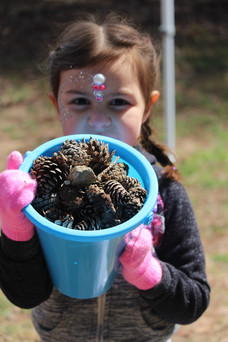By Ty Cryan, Davidson College intern
“Look – over there!” I said to my dad, pointing to a Great Horned Owl in the neighbor’s yard. The owl had just swooped from a tree in pursuit of a mouse scurrying from bush to bush. I pondered this great display of nature in our suburban neighborhood, then it hit me: this yard was full of native bushes, shrubs, and flowers. In our backyard, grass dominates, and owls are mostly absent. It was time for a change. How could we make our backyard a habitat for wildlife?

Here's what I learned…
According to the National Wildlife Federation, there are five essential elements for a hospitable and sustainable backyard habitat:
FOOD
Food includes a range of items, from traditional seeds and berries to nectar, leaves, or even sap! While a bird feeder is a great addition, planting native bushes, shrubs, trees, and flowers holistically improves your backyard environment and provides food to wild animals.
WATER
You can provide water for your backyard critters by installing a bird bath, rain garden, or by converting a portion of your yard into a backyard marsh! For more options, check the NWF Garden Certification checklist.
COVER
Just like you, animals require shelter from extreme weather and temperatures. Many animals also need a place to hide away from predators. Provide shelter through rock piles, bird houses, or native plants. Hang up that rake! Leaf litter and brush provide shelter for a plethora of animals from chipmunks to earthworms.
SUSTAINABLE PRACTICES
Conserve soil and water by using mulch and rain barrels. Remove invasive species and plant native species so you won’t have to use inorganic fertilizer and pesticides.
PLACES TO RAISE YOUNG
All organisms require a safe place to grow up, and large trees, wetland areas, or … you guessed it -- native plants provide ideal natural habitat for these small creatures. You can also help by building bird houses, bat houses, or an owl nesting box! See how here.

If you haven’t figured it out by now, native plants are the secret weapon when building your backyard habitat! Planting natives provides food, cover, and places to raise young for the animals that are supposed to be there!. Not to mention it’s sustainable, too. When planted in the right location, natives require less resources than other plants as they thrive in the soil, moisture, and weather natural to our region. To locate the native plants best for your yard, look here.
Not convinced? Converting your yard into a backyard habitat offers a range of benefits for yourself and the environment, especially within the context of a rapidly urbanizing Mecklenburg County. Compared to a grass lawn, a ‘wild’ yard pulls CO2 out of the atmosphere, requires less water and fertilizer, reduces runoff pollution, and increases biodiversity, all positives for the environment. A backyard habitat also saves you time and money on upkeep, is aesthetically pleasing, and attracts entertaining and beautiful creatures to your doorstep.
It’s a process that can be done in one vigorous weekend or over the course of several years, but one thing is certain, the rewards of brilliant butterflies, scurrying chipmunks, and maybe even a resident owl will be well worth the effort!

















